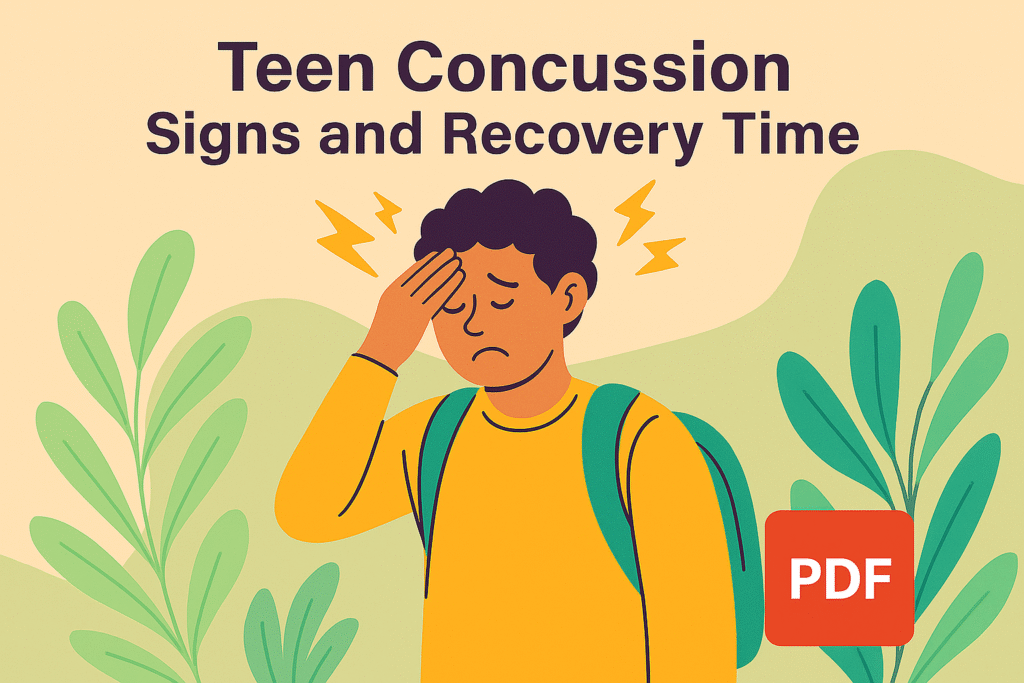A slip on damp stairs, a collision on the soccer field, or a fall during a basketball game can all occur in an instant. A concussion is more than just a “bump on the head” for teenagers, whose bodies and minds are still developing; it’s a medical incident that requires careful consideration.
In today’s fast paced world, we often rush back to “normal” after injury. But when it comes to the brain, recovery isn’t about rushing. It’s about recognizing the Early Warning Signs & Realistic Recovery Timelines , and giving the body (and mind) the space it needs to heal fully.
🧠 What Exactly Is a Concussion?
A concussion is a mild traumatic brain injury (TBI) caused by a blow, jolt, or bump to the head. It temporarily disrupts normal brain function. And while it might not show up on an X-ray or scan, its effects are very real especially for teenagers.
Their brains are still forming, which makes them more vulnerable to long term consequences if a concussion is not properly managed.
🚨 Early Signs of a Concussion in Teens You Shouldn’t Ignore
Symptoms may show up immediately or take hours (even days) to surface. That’s why it’s so important to monitor a teen after any head impact, even if they “feel fine.”
Look for:
- Persistent headaches
- Dizziness or balance problems
- Confusion, trouble concentrating, or “brain fog”
- Irritability or sudden mood changes
- Blurred vision or sensitivity to light and noise
- Fatigue or excessive drowsiness
- Nausea or vomiting
- Memory issues like forgetting what happened before or after the injury
Sometimes teens may downplay these symptoms to avoid being benched in sports or missing school. As a parent, caregiver, or coach, it’s important to trust your instincts and observe behavior changes. And Early Warning Signs & Realistic Recovery Timelines.

⏳ Realistic Recovery Timelines for Teen Concussions
Every brain heals differently. Some teens bounce back in a week, others need several. Here’s a general breakdown:
First Week :
- Physical and mental rest is critical.
- Limit screen time, noise, and fast paced thinking.
- No sports or intense activity.
Second & Third Week :
- Light physical activity (like walking) may begin, with medical approval.
- Gradual return to school with academic adjustments (shortened days, extended test time).
Forth Week Onwards :
- Return to full school and sports only when completely symptom free and cleared by a healthcare provider.
- Post concussion testing may be used to confirm brain readiness.
Rushing back can lead to Second Impact Syndrome a dangerous condition that occurs when a second concussion hits before the first has healed. It can have lifelong effects or even be fatal.
🛠️ Supporting Your Teen Through Recovery
Healing from a concussion isn’t just about lying in bed. It’s also about emotional support, patience, and a healthy environment.
Here’s how you can help:
- Be present. Listen to how they feel, even if it’s “just a little foggy.”
- Communicate with schools and coaches to adjust expectations.
- Promote healthy sleep, hydration, and nutrition.
- Stay calm. Anxiety can delay healing yours and theirs.
And remember: Rest doesn’t mean isolation. A healing brain still needs laughter, connection, and encouragement just in smaller doses.
💬 Final Thoughts: Recovery Takes Time And That’s Okay
There’s no shortcut to healing a brain. But there is a path one built on awareness, compassion, and the courage to slow down.
If you’re a parent, teacher, or coach, your calm guidance during this time can make a lasting difference in a teen’s recovery and their long term well being.
Visit more blogs for your daily life problems here
It’s packed with checklists, symptom trackers, and step by step advice for both parents and teens.
👉 Help them heal with confidence the smart way.

